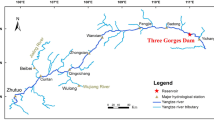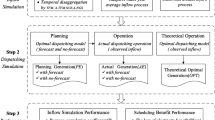Abstract
In the research and application of reservoir operation chart, few studies have paid attention to the time scale problem of operation stage, and there are almost no conclusions about the relationship between power generation and operation stage length. In view of this, the drawing method of Energy Storage Operation Chart (ESOC) and its simulation operation processes are studied in this paper. Cascade hydropower station of Yalong River is taken as research object, and its ESOCs under different time scales (5d, 10d, 15d, 20d, 30d and 60d) are derived. Through simulation calculation and statistical analysis, a different conclusion with the deterministic optimization of reservoir operation is drawn. That is, the larger the time scale of operation stage is, the greater the power generation will be. Adjacent growth of 5d, 10d, 15d, 20d, 30d and 60d is 0.77%, 1.61%, 0.49%, 0.73% and 3.49%, respectively. To analyze the cause of this scale effect, this paper divided the operation of a hydrological year into two periods (i.e., wet season and dry season), and derived the water level variation of each period under different time scales respectively. Reason for this scale effect is explained by this derived water level variation, and further verified through the phased statistical data. Furthermore, through simulation calculation of Jinxi hydropower station on shorter time scale, the best time scale in making med- and long-term plans in actual production operation is concluded, which has important guiding significance for actual reservoir operation.









Similar content being viewed by others
References
Ahmadi M, Haddad OB, Mariño MA (2014) Extraction of flexible multi-objective real-time reservoir operation rules. Water Resour Manag 28(1):131–147
An Q, Liang C, Liu Z (2008) Wavelet analysis of runoff variation characteristics in upper-middle reaches of Yalong River. Eng J of Wuhan Uni 41(3):20–24
Chang F, Hui S, Chen Y (2002) Reservoir operation using grey fuzzy stochastic dynamic programming. Hydrol Process 16(12):2395–2408
Chen L, Singh VP (2018) Entropy based derivation of generalized distributions for hydrometeorological frequency analysis. J Hydrol 557:699–712
Garegnani G, Sacchelli S, Balest J, Zambelli P (2018) GIS-based approach for assessing the energy potential and the financial feasibility of run-off-river hydro-power in alpine valleys. Appl Energy 216:709–723
Haghighi A, Najl AA, Samani HMV (2016) Simultaneous optimization of operating rules and rule curves for multireservoir systems using a self-adaptive simulation-GA model. J Water Resour Plan Manag 142(10):04016041
Ji C, Jiang Z, Sun P, Zhang Y, Wang L (2015) Research and application of multidimensional dynamic programming in cascade reservoirs based on multilayer nested structure. J Water Resour Plan Manag 141(7):1–13
Jiang Z, Ji C, Qin H, Feng Z (2018a) Multi-stage progressive optimality algorithm and its application in energy storage operation chart optimization of cascade reservoirs. Energy 148:309–323
Jiang Z, Wu W, Qin H, Zhou J (2018b) Credibility theory based panoramic fuzzy risk analysis of hydropower station operation near the boundary. J Hydrol 565:474–488
Jiang Z, Li R, Li A, Ji C (2018c) Runoff forecast uncertainty considered load adjustment model of cascade hydropower stations and its application. Energy 158:693–708
Jothiprakash V, Shanthi G (2006) Single reservoir operating policies using genetic algorithm. Water Resour Manag 20(6):917–929
Lai X, Li C, Zhang N, Zhou J (2018) A multi-objective artificial sheep algorithm. Neural Comput Applic 1:1–35
Li L, Liu P, Rheinheimer D, Deng C, Zhou Y (2014) Identifying explicit formulation of operating rules for multi-reservoir systems using genetic programming source. Water Resour Manag 28(6):1545–1565
Li R, Wei P, Ji C, Wang B (2017) Analysis of runoff tendency characteristics of Yalong River for past 6 decades. Yangtze Riv 48(5):38–42
Li R, Jiang Z, Ji C, Li A, Yu S (2018) An improved risk-benefit collaborative grey target decision model and its application in the decision making of load adjustment schemes. Energy 156:387–400
Liu P, Guo S, Xu X, Chen J (2011) Derivation of aggregation-based joint operating rule curves for cascade hydropower reservoirs. Water Resour Manag 25(13):3177–3200
Lu D, Wang B, Wang Y, Zhou H, Liang Q, Peng Y, Roskilly T (2015) Optimal operation of cascade hydropower stations using hydrogen as storage medium. Appl Energy 137:56–63
Moiz A, Kawasaki A, Koike T, Shrestha M (2018) A systematic decision support tool for robust hydropower site selection in poorly gauged basins. Appl Energy 224:309–321
Räsänen TA, Varis O, Scherer L, Kummu M (2018) Greenhouse gas emissions of hydropower in the Mekong River basin. Environ Res Lett 13:034030
Suiadee W, Tingsanchali T (2010) A combined simulation–genetic algorithm optimization model for optimal rule curves of a reservoir: a case study of the Nam Oon irrigation project, Thailand. Hydrol Process 21(23):3211–3225
Taghian M, Dan R, Haghighi A, Madsen H (2013) Optimization of conventional rule curves coupled with hedging rules for reservoir operation. J Water Resour Plan Manag 140(5):693–698
Vate JV (2002) Full-energy-chain greenhouse-gas emissions: a comparison between nuclear power, hydropower, solar power and wind power. Int J Risk Assess Manag 3(1):59–74
Xie X (2005) Reservoir regulation method adapted to the load demand of the power system. Water Pow 31(9):75–80
Zhang Y, Jiang Z, Ji C, Sun P (2015) Contrastive analysis of three parallel modes in multi-dimensional dynamic programming and its application in cascade reservoirs operation. J Hydrol 529:22–34
Acknowledgements
This study was financially supported by National Key R&D Program of China (2017YFC0405900), the Natural Science Foundation of China (51809098, 91647114 and 91547208) and the Fundamental Research Funds for the Central Universities (HUST: 2017KFYXJJ 198 and HUST: 2016YXZD047). The authors are grateful to the anonymous reviewers for their comments and valuable suggestions.
Author information
Authors and Affiliations
Corresponding author
Ethics declarations
Conflict of Interest
None.
Additional information
Publisher’s Note
Springer Nature remains neutral with regard to jurisdictional claims in published maps and institutional affiliations.
Rights and permissions
About this article
Cite this article
Jiang, Z., Qin, H., Ji, C. et al. Effect Analysis of Operation Stage Difference on Energy Storage Operation Chart of Cascade Reservoirs. Water Resour Manage 33, 1349–1365 (2019). https://doi.org/10.1007/s11269-018-2181-4
Received:
Accepted:
Published:
Issue Date:
DOI: https://doi.org/10.1007/s11269-018-2181-4




